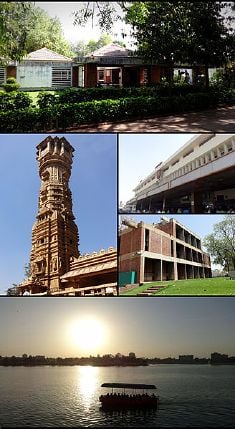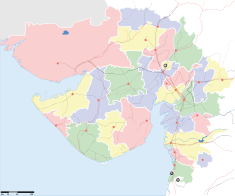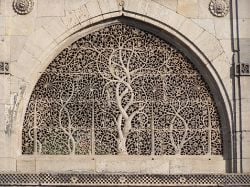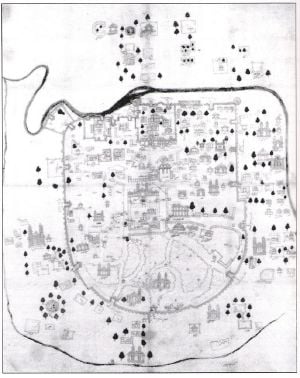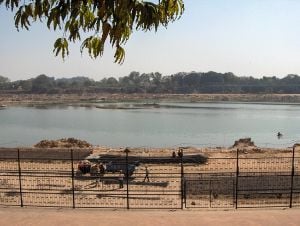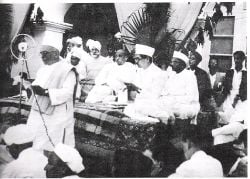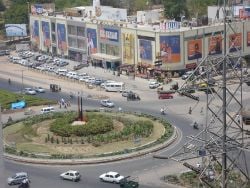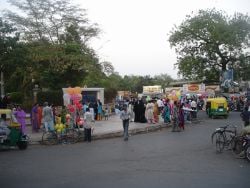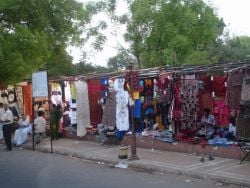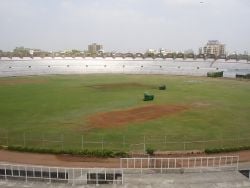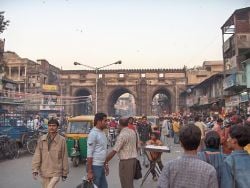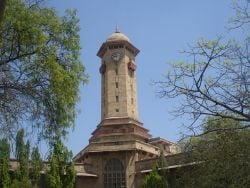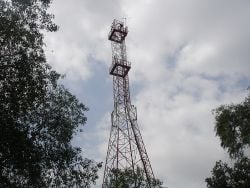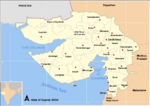Ahmedabad
| અમદાવાદ Ahmedabad Gujarat • India | |
| Nickname: | |
| Coordinates: | |
| Time zone | IST (UTC+5:30) |
| Area • Metro • Elevation |
475 km² (183 sq mi) • 10,000 km² (3,861 sq mi) • 53 m (174 ft) |
| District(s) | Ahmedabad |
| Population • Density • Metro • Sex ratio • Literacy rate |
5,897,312[4] (2011) • 22,473 /km² (58,205 /sq mi) • 6,352,254[5][6] (7th) (2011) • 1.11[2] • 92.5%[3] |
| Language(s) | Gujarati, Hindi, English[7] |
| Mayor | Asit Vora |
| Deputy Mayor | Darshna Vaghela |
| Municipal commissioner | Guruprasad Mohpatra |
| Civic agency | Ahmedabad Municipal Corporation |
| Codes • Pincode • Telephone • Vehicle |
• 380 0XX • +079 • GJ-1 |
Coordinates:
Ahmedabad (Gujarati: અમદાવાદ Amdāvād, Hindi: अहमदाबाद Ahmadābād), the largest city in the state of Gujarat and the seventh-largest urban agglomeration in India. Located on the banks of the River Sabarmati, the city serves as the administrative center of Ahmedabad district, and had been the capital of Gujarat from 1960 to 1970; the capital shifted to Gandhinagar thereafter. The city sometimes goes by the name Karnavati, a name for an older town that existed in the same location. Locals often use colloquial Gujarati, calling the city Amdavad.
Founded in 1411, the city served as the capital of the Sultanate of Gujarat, by its namesake, Sultan Ahmed Shah. The British established a military cantonment and the city infrastructure modernized and expanded. Although incorporated into the Bombay Presidency during the British rule in India, Ahmedabad remained the most important city in the Gujarat region. The city established itself as the home of a booming textile industry, which earned it the nickname "the Manchester of the East." The city was at the forefront of the Indian independence movement in the first half of the twentieth century. It became the epicenter of many campaigns of civil disobedience to promote workers' rights, civil rights and political independence.
With the creation of the state of Gujarat in 1960, Ahmedabad gained prominence as the political and commercial capital of the state. Once characterized by dusty roads and bungalows, the city has been witnessing a major construction boom and population increase. A rising center of education, information technology and scientific industries, Ahmedabad remains the cultural and commercial heart of Gujarat, and much of western India. Since 2000, the city has been transformed through the construction of skyscrapers, shopping malls and multiplexes. That progress has been marred by natural calamities, political instability, and outbreaks of communal violence.
History
Archaeological evidence suggests that the area around Ahmedabad has been inhabited since the eleventh century, then known as Ashapalli or Ashaval. At that time, Karandev I, the Solanki ruler of Anhilwara (modern Patan), waged a successful war against the Bhil king of Ashaval. Soon after the victory, he established a city called Karnavati on the banks of the Sabarmati at the site of modern Ahmedabad. Solanki rule lasted until the thirteenth century, when Gujarat came under the control of the Vaghela dynasty of Dholka and the Sultanate of Delhi conquered Ahmedabad.
In 1411 , the Muzaffarid dynasty established its rule in Gujarat. According to tradition, Sultan Ahmed Shah, while camping on the banks of the River Sabarmati, saw a hare chasing a dog. Impressed by that act of bravery, the Sultan, who had been looking for a place to build his new capital, decided to locate the capital here and called it Ahmedabad.[8]
In 1487, Mahmud Begada, the grandson of Ahmed Shah, fortified the city with an outer wall 10 km (6 miles) in circumference and consisting of twelve gates, 189 bastions and over 6,000 battlements. The Muzaffarid dynasty ruled Ahmedabad until 1573 when Muzaffar II became the Sultan of Ahmedabad. the Mughal emperor Akbar Gujarat then conquered in 1573. During the Mughal reign, Ahmedabad became one of the Empire's thriving centers of trade, mainly in textiles, exported to as far as Europe. The Mughal ruler Shahjahan spent the prime of his life in the city, sponsoring the construction of the Moti Shahi Mahal in Shahibaug. The armies of the Maratha generals Raghunath Rao and Damaji Gaekwad captured the city and ended Mughal rule in Ahmedabad. A famine in 1630 and the constant conflicts between the Peshwa and the Gaekwad armies virtually destroyed many parts of the city, causing its population to flee.[9] The British East India Company took over the city in 1818, as a part of the conquest of India. They established a military cantonment in 1824 and a municipal government in 1858. In 1864, the Bombay, Baroda, and Central India Railway (BB&CI) established a railway link between Ahmedabad and Mumbai (then Bombay), making Ahmedabad an important junction in the traffic and trade between northern and southern India. Large numbers of people migrated from rural areas to work in textile mills, establishing a robust industry.
The Indian independence movement developed strong roots in the city when, in 1915, Mahatma Gandhi established two ashrams—the Kochrab Ashram near Paldi in 1915 and the Satyagraha Ashram on the banks of the Sabarmati in 1917—that would become centers of intense nationalist activities. During the mass protests against the Rowlatt Act in 1919, textile workers burned down 51 government buildings across the city in protest at a British attempt to extend wartime regulations after the First World War.[10] In the 1920s, textile workers and teachers went on strike, demanding civil rights and better pay and working conditions. In 1930, Gandhi initiated the Salt Satyagraha from Ahmedabad by embarking from his ashram on the famous Dandi Salt March. The large masses of people who took to the streets in peaceful protests in the early 1930s, and again in 1942 during the Quit India movement rendered functionless the city administration and economic institutions. Following independence and the partition of India in 1947, intense communal violence that broke out between Hindus and Muslims scarred the city.
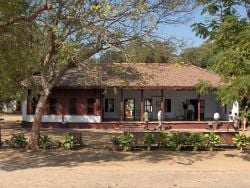
Ahmedabad became the capital of the new state of Gujarat after the bifurcation of the State of Bombay on 1 May 1960. During that period, a large number of educational and research institutions sprung up in the city, making it a major center of higher education, science and technology. The establishment of heavy and chemical industries in its vicinity around the same period diversified Ahmedabad's economic base. But political events in and around the city the punctuated growth in the next two decades. In February 1974, Ahmedabad occupied the center stage in national politics with the launch of the Nav Nirman agitation — a protest against a 20% hike in the hostel food fees at the L.D. College of Engineering that snowballed into a mass agitation to remove Chimanbhai Patel, then-chief minister of Gujarat, on charges of corruption.[11] In the 1980s, the government introduced a reservation policy in the country, which led to anti-reservation protests in 1981 and 1985. The protests witnessed violent clashes between people belonging to various castes.[12]
On January 26, 2001, a devastating earthquake struck the city, centered near Bhuj, measuring 6.9 on the Richter scale. As many as 50 multistory buildings collapsed, killing 752 people and devastating the city's infrastructure.[13] The following year, communal riots between Hindus and Muslims spread to Ahmedabad, paralyzing the city for more than a month. The crisis resulted in the deaths of an estimated 1,044 people across the state.[14] The displacement of thousands of Muslims led to the erection of refugee camps around the city.
In recent years, the effects of globalization and the liberalization of the Indian economy has energized the city's economy.[15] The city has witnessed the establishment of scientific and service industries, the expansion of the information technology sector, and significant improvements in transportation and communications. Ahmedabad's population has been growing, resulting in a construction and housing boom. That has challenged the city's infrastructure and power supply.[15]
Geography and climate
Ahmedabad, located at in western India, stands at an elevation of 53 metres (174 feet). The city sits on the banks of the River Sabarmati, in north-central Gujarat. It spans an area of 205 km² (79.15 square miles). The Sabarmati frequently dries up in the summer, leaving only a small stream of water. With the city located in a sandy and dry area, many of the localities and roads build in sand, reflecting the intensifying fallout caused by deforestation. The steady expansion of the Rann of Kutch threatens to increase desertification around the city area and much of the state. Except for the small hills of Thaltej-Jodhpur Tekra, the city sits in an almost flat area. Two lakes lie within the city's limits—Kankaria Lake and Vastrapur Lake. The Sultan of Delhi, Qutb-ud-din Aybak, dug Kankaria lake, in the neighborhood of Maninagar, in 1451.[16] According to the Bureau of Indian Standards, the town falls under seismic zone-III, in a scale of I to V (in order of increasing proneness to earthquakes)[17] while the wind and cyclone zoning rates "very high damage risk," according to UNDP report.[17]
Three main seasons exist: Summer, monsoon and winter. Aside from the monsoon season, the climate remains dry. The weather, hot through the months of March to June—experiences a summer maximum of 36 °C (97 °F), and the average minimum of 23 °C (73 °F). From November to February, the average maximum temperature measures 30 °C (85 °F), the average minimum 15 °C (59 °F), with an extremely dry climate. Cold northerly winds brings a mild chill in January. The southwest monsoon ushers a humid climate from mid-June to mid-September. The average rainfall measures 93.2 cm (36.7 inches), but infrequent heavy torrential rains cause the river to flood. The highest temperature recorded reached 47 °C (116.6 °F) and the lowest fell to 5 °C (41 °F).[18] In recent years, Ahmedabad has suffered from increasing air, water and soil pollution from neighboring industrial areas and textile mills.
The Sabarmati divides Ahmedabad into two physically distinct eastern and western regions. The eastern bank of the river houses the old city, including the central town of Bhadra. Packed bazaars, the clustered and barricaded pol system of shanty buildings, and numerous places of worship characterize that part of Ahmedabad. It houses the main railway station, the General Post Office, and landmark buildings of the Muzaffarid and British eras. The colonial period saw the expansion of the city to the western side of Sabarmati, facilitated by the construction of Ellis Bridge in 1875 and later with the modern Nehru Bridge. That part of the city houses educational institutions, modern buildings, well-planned residential areas, shopping malls, multiplexes and new business districts centered around C. G. Road, Ashram Road, and more recently, the Sarkhej-Gandhinagar Highway.[19]
Civic administration
The Ahmedabad Municipal Corporation (AMC) administered Ahmedabad. The Ahmedabad Urban Development Authority (AUDA) administer some of the regions surrounding the city. The AMC established in July 1950 under the Bombay Provincial Corporation Act, 1949. Administratively, the city divides into five zones and 43 wards. Each ward elects three corporators,[20] who in turn elect a mayor. The municipal commissioner, an IAS officer appointed by the Gujarat state government, has vested executive powers. The mayor governs the day-to-day running of the municipal school board, the city bus service, the municipal hospital, and the city library. The city serves as the headquarters of Ahmedabad district and as the seat of the Gujarat High Court.
A Police Commissioner, an IPS officer heads the Ahmedabad city police. Torrent Power AEC Limited, previously a state-run corporation provides electricity in the city. The city elects one member to the Lok Sabha and seven to the Gujarat Vidhan Sabha. Two main political parties have won a significant number of seats in elections—the Bharatiya Janata Party and the Indian National Congress. Of the seven assembly seats of Ahmedabad, the BJP won five and the Congress Party two during the legislative elections in 2002. In the 2005 Ahmedabad Municipal Corporation elections, the BJP won 96 seats, 32 seats went to the Congress, and one seat went to an independent candidate.[21]
Economy
Ahmedabad, the largest inland industrial center in western India, has historically enjoyed a reputation as an important base of commerce, trade and industry. Under Muzaffarid rule, the city constituted a major trade destination for western India, because of its proximity to the port at Surat and for its access to the hinterland of Gujarat. In the nineteenth century, the textile and garments industry developed and thrived in the city—on May 30, 1861, Ranchhodlal Chhotalal founded the first Indian textile mill, the Ahmedabad Spinning and Weaving Company Limited. The establishment of a series of textile mills such as the Calico Mills in 1880, by Maganbhai, and mills founded by industrialists such as Ambalal Sarabhai and Kasturbhai Lalbhai followed.[22] Arvind Mills, located in Ahmedabad, is one of the largest textile mills in the country.
Ahmedabad has a thriving chemicals and pharmaceuticals industry. Two of the biggest pharmaceutical companies of India — Zydus Cadila and Torrent Pharmaceuticals — headquarter in the city. The city serves as the corporate headquarters of the Adani Group, a leading multinational trading company. The Nirma group of industries, which runs a large number of detergent and chemical industrial units, has its corporate headquarters in the city. In recent year many foreign companies have set up their sales offices and production facilities in Ahmedabad, among them Bosch Rexroth, Germany (hydraulic components); Stork, Netherlands (textile machinery; joint venture with ATE, India's leading textile equipment trading house); Rollepaal, Netherlands (pipe extrusion equipment); and Johnson Pumps, Sweden.
The completion and operation of the Sardar Sarovar Project of dams and canals has improved the supply of potable water and electricity for the city. In recent years, the Gujarat government has increased investment in the modernization of the city's infrastructure, providing for the construction of larger roads and improvements to water supply, electricity and communications. The information technology industry has developed significantly in Ahmedabad. A NASSCOM survey in 2002 on the "Super Nine Indian Destinations" for IT-enabled services ranked Ahmedabad fifth among the top nine most competitive cities in the country.[23]
A diverse labor force of migrant workers from different parts of Gujarat and neighboring states has been integral to the economy of the city. Those workers provide vital household labor and services for the city's large middle class. Ahmedabad plays a strong and significant role in providing commercial resources and market access for the economies of neighboring cities. A majority of the working-age citizens of Ahmedabad work as traders and business people. That has led to the creation of major mercantile corporations and artisan guilds that exert a key influence on the economic life of Gujarat. The city's educational and industrial institutions have attracted students and young skilled workers from the rest of India.
Demographics
As of 2001, India census,[24] Ahmedabad had a population of 3,515,361. That figure accounts only for the municipal region. The total population of the Ahmedabad Urban Agglomeration (which includes the region governed by AUDA) came to 4.5 million, having grown to an estimated 5.2 million in 2006.[25] Ahmedabad has a sex ratio of 886 females to every 1000 males, and a literacy rate of 79.89 percent, the highest in Gujarat (87.81 percent males and 71.12 percent females).[26] According to the census for the Ninth Plan, 30,737 families live in rural Ahmedabad. Of those, 5.41 percent (1663 families) live below the poverty line.[27] Approximately 440,000 people live in slums in the city.[28] Ahmedabad serves as home to a large population of Vanias (that is, traders), belonging to the Vaishnava sect of Hinduism and the sects of Jainism. Most of the residents of Ahmedabad number among the native Gujaratis. Residents commonly speak Hindi and English, especially in commerce, education, politics and government.
Ever since its foundation, the city has attracted migrant workers from other areas of Gujarat including Kutch and Saurashtra and from the neighboring states of Rajasthan and Maharashtra as well as the Pakistani province of Sindh. A sizeable population of Punjabis, Marathis, Tamils, Sindhis, Malayalis and Marwaris bring their native language and culture to the city. The military base near the city, and government institutions such as ONGC, bring an influx of people from across India. Ahmedabad enjoys great religious diversity. According to the 2001 census, 84.62% of the people in Ahmedabad profess Hinduism, 2.92% Jainism, 11.4% Islam and 0.72% Christianity.[29] The community of Muslims has cultural significance in Ahmedabad, dating back to the times of the sultanate. Most Muslims live in the old town, especially Bhadra. A major population of Parsis call the city home, and a community of 300 Bene Israel Jews live in Ahmedabad.[30]
Culture
Ahmedabad enjoys a thriving cultural tradition, being the center of Gujarati cultural activities and diverse traditions of different ethnic and religious communities. Popular celebrations and observances include Uttarayan—an annual kite-flying day on January 14. People performing Garba—the folk dance of Gujarat — celebrate the nine nights of Navratriat venues across the city. The lighting of lamps in every house, the decorating the floors with the rangoli and the bursting of firecrackers celebrate the festival of lights — Deepavali. People celebrate other festivals such as Holi, Eid ul-Fitr and Christmas with enthusiasm. The annual Rath Yatra procession on the Ashadh-sud-bij date of the Hindu calendar and the procession of Tajia during the Muslim holy month of Muharram are integral parts of the city's culture. The people of Ahmedabad enjoy rich culinary traditions. The most popular form of meal—a typical Gujarati thali (meal) — consists of rotli, dal, rice, and Shaak (cooked vegetables, sometimes with curry), with accompaniments of pickles and roasted papads. Popular beverages include buttermilk and tea; sweet dishes include laddoos and mango. Many restaurants serve a wide array of Indian and international cuisines. Most of the food outlets serve only vegetarian food, as the city's Jain and Hindu communities maintain a strong tradition of vegetarianism. The first all-vegetarian Pizza Hut in the world opened in Ahmedabad.[31]
The architectural history of Ahmedabad stretches across the last millennium. The Sultanate fused Hindu craftsmanship with Islamic architecture, giving rise to the Indo-Saracenic style. Many mosques in the city have been built in that fashion.[32]
After independence, modern buildings came up in Ahmedabad when renowned architects like Louis Kahn who designed the Indian Institute of Management; Le Corbusier who designed the Shodhan and Sarabhai Villas, the Sanskar Kendra and the Mill Owner's Association; and Buckminister Fuller who designed the Calico Dome received commissions in the city. B. V. Doshi came to the city from Paris to supervise Le Corbusier's works and later set up the School of Architecture. His local masterpieces include Sangath, the Doshi-Hussain Gumpha and the School of Architecture. Charles Correa, who became a partner of Doshi's, designed the Gandhi Ashram and Achut Kanvinde the Indian Textile Industries Research Association. Christopher Charles Benninger's first work, the Alliance Francaise, stands in the Ellis Bridge area. Hashmuck C. Patel, and his son Dr. Bimal Patel, both renowned architects of the city, designed the St. Xavier's High School Loyola Hall, Gujarat High Court and the Ahmedabad Management Association. Dr. Bimal Patel recently designed a major addition to Louis Kahn's campus, the Indian Institute of Management.
Parts of Ahmedabad have earn fame for their speciality of folk art, including the Paldi area famous for shops selling works of embroidery from the Kutch and Saurashtra regions. The artisans of Rangeela pol have become famous for making bandhinis (tie and dye work), while the cobbler shops of Madhupura sell traditional mojri footwear. High-quality idols of Ganesha and other religious icons have been produced in huge numbers in the Gulbai Tekra area. The shops at the Law Garden have achieved fame for their mirror work handicraft. Victorian architecture showcases in most college, railway station and government buildings, mainly constructed during the colonial period.
Many Gujarati intellectuals migrated to Ahmedabad due to its prosperity. Three main literary institutions were established in Ahmedabad for the promotion of Gujarati literature — Gujarat Vidhya Sabha, Gujarati Sahitya Parishad and Gujarat Sahitya Sabha. Musicians and instrumentalists from across the world come to perform at the popular classical music festival held each January 1, by the Saptak School of Music. The Sanskar Kendra—one of the many buildings in Ahmedabad designed by Le Corbusier—is a city museum depicting history, art, culture and architecture of Ahmedabad. The Gandhi Smarak Sangrahalaya and the Sardar Vallabhbhai Patel National Memorial have a permanent display of photographs, documents and other articles of Mahatma Gandhi and Sardar Patel. The Calico Museum of Textiles has a large collection of Indian and international fabrics, garments and textiles. Ahmedabad maintains a strong popular literary tradition in large public libraries maintained by the literary societies, research and government institutions and colleges. The Hazrat Pir Mohammad Shah Library has a collection of rare original manuscripts in Arabic, Persian, Urdu, Sindhi and Turkish languages.
Sports
Cricket ranks as the most popular sport in the city. Both one-day internationals and test matches play at the Sardar Patel Stadium. The stadium has frequently served as venue for matches during major tournaments such as the 1987 Cricket World Cup, the 1996 Cricket World Cup and the 2006 ICC Champions Trophy. Ahmedabad has a second cricket stadium at the Ahmedabad Municipal Corporation's Sports Club of Gujarat, the home ground of the Gujarat cricket team. The stadium serves as the venue for domestic tournaments such as the Ranji Trophy, the Duleep Trophy and many inter-school and collegiate tournaments. Even though overshadowed by cricket's popularity, football, field hockey, badminton, tennis, squash and basketball have been gaining popularity at collegiate levels. There has been a significant increase in recent years in the number of private sports clubs, gymkhanas, gymnasiums and sports teams sponsored by corporations, private associations, schools and colleges. Young people congregate in the evenings to play cricket and football on the numerous public and neighbourhood grounds. Ahmedabad's rich sports traditions have produced legendary sportsmen, such as Jasu Patel, and younger stars such as Parthiv Patel and Geet Sethi, a five-time winner of the World Professional Billiards Championship and a recipient of India's highest sporting award, the Rajiv Gandhi Khel Ratna.
Transport
Ahmedabad numbers among one of the six operating divisions of the Western Railway. Railway lines connect the city to all towns in Gujarat, and to major cities in the rest of India. The Ahmedabad Railway Station and the Maninagar Railway Station served as the main terminals for the city. The Sardar Vallabhbhai Patel International Airport provides for both domestic and international aviation for the city and the neighboring cities of Gandhinagar, Mehsana and Nadiad. The airport connects the city with destinations across India and to cities in the Middle East (Muscat, Sharjah, Kuwait), East Asia (Singapore) and destinations in Western Europe (London).
National Highway 8, linking Delhi to Mumbai, passes though Ahmedabad. Ahmedabad connects to Vadodara through National Expressway 1, a 94 km (58 mi) long highway with only two exits. That expressway belongs to the Golden Quadrilateral project. Highways directly connect Ahmedabad to Bhavnagar, Nadiad, Mehsana, Surendranagar, Bhuj, Rajkot and Gandhinagar.
The Mahatma Gandhi Road, C. G. Road, the Jawaharlal Nehru Road, the Ashram Road and the Sarkhej-Gandhinagar highway (S.G. Highway) make up the city's main traffic arteries. Auto rickshaws, share autos and buses rank as the most popular forms of public transport. The Ahmedabad Municipal Transport Service (AMTS) runs the local bus service in the city. In 2005, AMTS began a drive to convert all of its petrol and diesel engine buses to run on compressed natural gas engines to reduce the effects of air pollution. AMTS runs 750 buses. Bicycles and motorcycles make a popular medium of transport with the city's young people and students. A bus rapid transport project has been launched by the Ahmedabad Municipal Corporation. The first phase of the project finished September 2007.[33]
Education
Either the municipal corporation, or privately by entities, trusts and corporations run schools in Ahmedabad. Most schools affiliate with the Gujarat Secondary and Higher Secondary Education Board. Some schools, like the Delhi Public School and the Kendriya Vidyalayas, relate to the Central Board for Secondary Education. A large number of colleges in the city affiliate with Gujarat University. Other deemed universities in Ahmedabad include the Dhirubhai Ambani Institute of Information and Communication Technology, Nirma University of Science & Technology and the Dr. Babasaheb Ambedkar Open University. Mahatma Gandhi established the prestigious Gujarat Vidyapith in 1920, among the first institutions of higher learning managed entirely by Indians, despite British control.
Prestigious institutions such as the Indian Institute of Management, the National Institute of Design, the Mudra Institute of Communications, the National Institute of Fashion Technology, the Entrepreneurship Development Institute of India, the Gujarat National Law University and the Center for Environmental Planning and Technology have campuses in Ahmedabad. Many national academic and scientific institutions, such as the Physical Research Laboratory and the Space Applications Centre of the Indian Space Research Organisation, established in the 1960s largely through the efforts of prominent astrophysicist and industrialist Vikram Sarabhai.[34] The Ahmedabad Management Association, a notable institution, imparts management training and experience to young students and professionals. A plan to open a satellite campus of the Indian Institute of Technology, Bombay, with a capacity of around 4,000 students, has been drafted. The IIT will offer courses with a focus on the skilled-labor needs of Gujarat, such as textiles, and aeronautical, marine, and ship engineering.[35]
Twelve Management Schools (other than IIM)Manaement Schools operate in and around Ahmedabad. B. K. School of Business Management , oldest among them, had been established in 1976 as a department of Gujarat University as a state run institute. The university ranks 3rd in Asia for its Part Time MBA program, 28th in India for its Full Time MBA program, and 6th among university sponsored MBA program. The business management college ranks as the first MBA institute, in the state of Gujarat among 45 institutes, in terms of common admission and placement criterion. The college runs an recognized program in Port Management.
Media
Ahmedabad has a number of newspaper publications. English-language dailies published and sold in the city include, The Times of India, Indian Express, DNA money, Economic Times, Indian Express, Divya Bhaskar, Gujarat Samachar, Sandesh.
A large number of magazines, periodicals and journals regularly publish and circulate across the city. The city serves as home to the historic Navajivan Publishing House — founded in 1919 by Mahatma Gandhi — one of India's premier publications company. The Gujarat film and television industry has a small but significant presence in the city.
The city has six local FM stations at Radio Mirchi (98.3 MHz), Radio City (91.1 MHz), My fm (94.3 MHz), Radio One (95.0 MHz), Gyan Vaani (104.5 MHz), All India Radio (96.7 MHz).
All India Radio broadcasts on the AM band.[36] Satellite radio was launched in the city by WorldSpace in 2005.[37] Households receive television through two main cable networks, InCablenet and Siti Cable, while DTH has little popularity in Ahmedabad. A network of optical fibre cables connects almost the entire city. Landline and mobile operators like BSNL, Reliance Infocomm, Airtel, Hutch and Tata Indicom provided the city's telephone services. The telecom companies provide Broadband Internet services in most parts of the city.
Sister cities
- Astrakhan, Russia
- Jersey City, United States of America (Since at least 2001)
- Ulsan, South Korea (Since 2000)
Notes
- ↑ A. Srivathsan, Manchester of the east, Young World. Retrieved February 12, 2009.
- ↑ Distrubution of Population, Decadal Growth Rate, Sex-Ratio and Population Density. 2011 census of India. Government of India. Retrieved April 25, 2012.
- ↑ Ahmadabad (Ahmedabad) : Census 2011 Retrieved April 25, 2012.
- ↑ Provisional Population Totals, Census of India 2011. World Gazetteer. Census of India. Retrieved April 25, 2012.
- ↑ India: metropolitan areas, World Gazetteer.
- ↑ Census of India 2011, Cities having population 1 lakh and above, Census 2011 Retrieved April 25, 2012.
- ↑ Ahmedabad Languages—Common Languages of Ahmedabad India—Language Spoken In Ahmedabad. ahmedabad.org.uk. Retrieved April 25, 2012.
- ↑ Setu City Map: Ahmedabad-Gandhinagar (Setu Publications, 1998).
- ↑ Ahmedabad Municipal Corporation, History of Ahmedabad. Retrieved February 12, 2009.
- ↑ Unjum Mirza, Socialist Review.
- ↑ Ahmedabad.com, When LD Engineering structured the revolt. Retrieved February 12, 2009.
- ↑ Seminar Publications, The pathology of Gujarat. Retrieved February 12, 2009.
- ↑ WHO Regional Office for South-East Asia, Lessons learned from the Gujarat earthquake.
- ↑ BBC News, Gujarat riot death toll revealed. Retrieved February 12, 2009.
- ↑ 15.0 15.1 Jeremy Smith, Professor Sees Philadelphia in Indian city, The Temple News. Retrieved February 12, 2009.
- ↑ Ministry of Tourism and Culture, India, Ahmedabad—What to see. Retrieved February 12, 2009.
- ↑ 17.0 17.1 UNDP, Hazard profiles of Indian districts. Retrieved February 12, 2009.
- ↑ Canty and Associates LLC, Weatherbase entry for Ahmedabad. Retrieved February 12, 2009.
- ↑ The Ahmedabad Chronicle: Imprints of a Millennium (Vastu-Shilpa Foundation for Studies and Research in Environmental Design, 2002).
- ↑ Ahmedabad Municipal Corporation, Administrative setup. Retrieved February 12, 2009.
- ↑ Manas Dasgupta, BJP wrests control of Ahmedabad municipal body. Retrieved February 12, 2009.
- ↑ The Ahmedabad Chronicle: Imprints of a Millennium (Vastu-Shilpa Foundation for Studies and Research in Environmental Design, 2002).
- ↑ Economic Times, Ahmedabad joins ITES hot spots. Retrieved February 12, 2009.
- ↑ GRIndia
- ↑ The Hindu, Ahmedabad yet to become a mega city.
- ↑ Mediaware Infotech Pvt. Ltd, Literacy in Gujarat.
- ↑ Ahmedabad District Collectorate, BPL Census for ninth plan. Retrieved February 12, 2009.
- ↑ Office of the Registrar General and Census Commissioner, India, Slum Population in Million Plus Cities. Retrieved February 12, 2009.
- ↑ Office of the Registrar General and Census Commissioner, India, Census GIS Household. Retrieved February 12, 2009.
- ↑ Jerusalem Centre for Public Affairs, The Last Jews in India and Burma. Retrieved February 12, 2009.
- ↑ Sumitra Senapaty, Bon `veggie' appetit, The Hindu Business Lines. Retrieved February 12, 2009.
- ↑ The Ahmedabad Chronicle: Imprints of a Millennium, (Vastu-Shilpa Foundation for Studies and Research, 2002).
- ↑ Tanvir A Siddiqui, BRTS project finally hits the road, off to a ‘flyover’ start, Ahmedabad Newsline. Retrieved February 12, 2009.
- ↑ ISRO, Ahmedabad. Retrieved February 12, 2009.
- ↑ Express India, IIT’s happening at last: satellite campus in offing. Retrieved February 12, 2009.
- ↑ Alan G. Davies, Radio Stations in Gujarat, India. Retrieved February 12, 2009.
- ↑ Worldspace Satellite Radio, WorldSpace Satellite Radio Lights Up Ahmedabad. Retrieved February 12, 2009.
ReferencesISBN links support NWE through referral fees
- Altekar, Anant Sadashiv. A History of Important Ancient Towns and Cities in Gujarat and Kathiawad (From the Earliest Times Down to the Moslem Conquest). ASIN B0008B2NGA.
- Crook, Nigel. 1993. India's Industrial Cities: Essays in Economy and Demography. Oxford University Press. ISBN 0195631722.
- Rajan, K. V. Soundra. 1989. Ahmadabad. Archaeological Survey of India.
- Forrest, George William. Cities of India. Adamant Media Corporation. ISBN 0-543-93823-9.
- Gandhi, R. 1990. Patel: A Life. Ahmedabad: Navajivan Press. ASIN B0006EYQ0A.
- Michell, George. 2003. Ahmadabad. Art Media Resources. ISBN 81-85026-03-3.
External links
All links retrieved June 16, 2023.
| ||||||||||||||||||||||||||||||||
| ||||||||||||||||
| |||||
| |||||
Credits
New World Encyclopedia writers and editors rewrote and completed the Wikipedia article in accordance with New World Encyclopedia standards. This article abides by terms of the Creative Commons CC-by-sa 3.0 License (CC-by-sa), which may be used and disseminated with proper attribution. Credit is due under the terms of this license that can reference both the New World Encyclopedia contributors and the selfless volunteer contributors of the Wikimedia Foundation. To cite this article click here for a list of acceptable citing formats.The history of earlier contributions by wikipedians is accessible to researchers here:
The history of this article since it was imported to New World Encyclopedia:
Note: Some restrictions may apply to use of individual images which are separately licensed.
